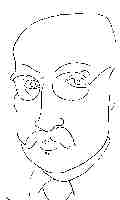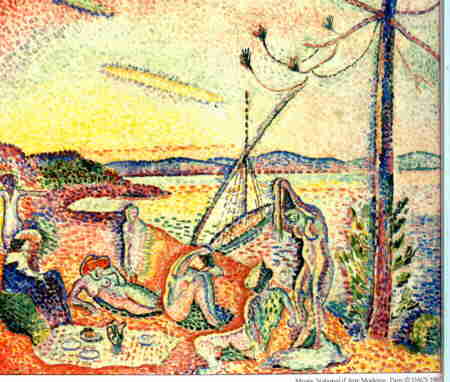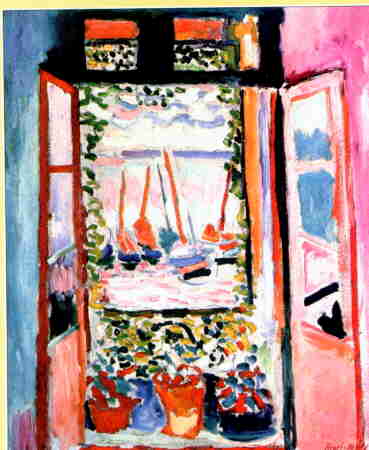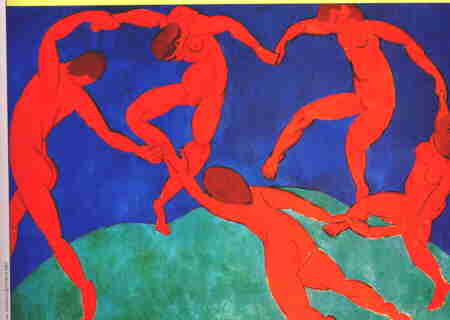 PART OF THE ARTSCHOOL
ONLINE NETWORK
PART OF THE ARTSCHOOL
ONLINE NETWORK
 THE
LIFE AND TIMES OF HENRI MATISSE
THE
LIFE AND TIMES OF HENRI MATISSE
Henri Matisse was one of the most innovative artists
of this century, equaled only by Picasso. His dazzling experiments with
color marked a turning point in the history of art, and formed the basis
for most subsequent artistic developments. Matisse took to painting relatively
late in life, while recovering from a brief illness. He immediately found
in it both an ideal means of expression and a refuge from everyday existence.
After a short period as leader of the Fauvist movement, Matisse forged
his own unique style, combining the simplicity of Cezanne with a brilliantly
expressive use of color. His radiant compositions came increasingly to
reflect his own aspirations for a life free from trouble and nervous excitement.
In reality, his life was largely uneventful, particularly his last years,
spent peacefully in the South of France.
Henri Emile Benoit Matisse was born on 31 December 1869
in the northern French town of Le Cateau, at his maternal grandmother's.
Both his parents came from Le Cateau, but had met in Paris where his mother,
Anna, had worked as a milliner and Emile, his father, had been a draper's
assistant. Shortly after the birth, the family moved to the nearby village
of Bohain-en-Vermandois, where Emile set up shop as a druggist and grain
merchant. This commercial heritage was to prove useful as, throughout his
life, Matisse displayed a keen business acumen.
DISCOVERING ART
At first, Matisse gave little indication of his future brilliance
and individuality as an artist. At the age of ten, he attended the lycee
in the neighboring town of St Quentin, studying Latin and Greek, and in
1887, he was sent to Paris to study law. But it was not until he was nearly
19, that he began to take a serious interest in art. Working as a lawyer's
clerk in St Quentin, he attended early morning drawing classes at the Ecole
Quentin de la Tour, working assiduously from plaster casts between 6:30
and 7:30 am each day. But it was when he was convalescing from appendicitis
the following year that he took up painting, and it came as a revelation
to him. He recalled later, "When I started to paint, I felt transported
into a kind of paradise....In everyday life, I was usually bored and vexed
by the things that people were always telling me I must do. Starting to
paint, I felt gloriously free, quiet and alone."
With his father's permission, Matisse gave up law and
set off for Paris again - this time, to study with the fashionable and
most successful academic painter of his day, Adolphe Bouguereau. But Matisse
was soon to become disillusioned with Bouguereau's facile and repetitive
productions. In 1892, he became an unofficial student at the Ecole des
Beaux-Arts under the aegis of Gustave Moreau. Moreau was a liberal and
open-minded teacher, who encouraged his students to follow their own paths
and to paint right from the start of the course to develop their gifts
as colorists. He not only urged Matisse to copy Old Masters in the Louvre,
but also to go into the streets and draw, taking his subject-matter from
everyday life. Matisse made close friends in Moreau's studio, among them,
Albert Marquet, who joined Matisse in "creating" Fauvism some five years
later.
Life for Matisse in Paris of the belle epoque
was a struggle. By 1894, he already had a daughter, Marguerite, to support
(like much of Matisse's personal life, her origins can only be the subject
of conjecture). But gradually, Matisse's relatively unadventurous early
works, consisting largely of still-lifes and interiors in subdued colors,
began to win him success within the Parisian artistic establishment. Four
were exhibited at the 1896 Salon of the Societe Nationale des Beaux-Arts
and at the end of the exhibition, Matisse was elected an Associate Member
of the Societe. He looked set on the road to a successful, if unexciting,
professional artistic career.
However, Matisse was never one to bow to the dictates
of fashion, or the demands of the academic establishment. During the following
year, he presented to the Salon an ambitious still-life The Dinning
Table (orLa Desserte) in an Impressionistic style. Although
Impressionism was over twenty years old, it was still an anathema to the
establishment. The Societe were bitterly disappointed by Matisse's entry,
and after 1899, he did not exhibit with them.
The next ten years were years of poverty and hardship
for Matisse, lightened only by his marriage in January 1898 to Amelie Parayre,
whom he had met a few months before at a wedding. She was to prove a devoted
wife and mother - Jean was born in 1899, Pierre, in 1900 - and like Matisse's
mother, set herself up as a milliner to support her husband's talent; she
also modeled for him for several years. Her love of Oriental patterned
fabrics is depicted in her husband's portraits of her in a Japanese kimono.
For their honeymoon, they went to London, where Matisse studied the Turners,
as advised by Pisarro. On their return to France, they made an extended
trip to Corsica - Matisse's first experience of the Mediterranean light
and color, which were to play such an important part in his art.
On their return to Paris, the Matisses set up home in
an apartment on the Quai St Michel, near Matisse's friend, Marquet. Here,
Matisse devoted himself to painting and sculpture, and, to alleviate financial
difficulties, took a job with a theatrical scene-painter, meticulously
painting miles of laurel leaves to decorate the hall then under construction
for the 1900 Exposition Universelle.
 The
first major turning point in Matisse's life came when he and his family
spent a summer holiday at St Tropez, near the villas of Paul Signac and
Henri-Edmond Cross, two major Neo-Impressionist painters. Under their influence,
Matisse began to paint in bright, vivid colors applied in a divisionist
technique, which was to culminate in Luxe, Calme et Volupte. (left)
The
first major turning point in Matisse's life came when he and his family
spent a summer holiday at St Tropez, near the villas of Paul Signac and
Henri-Edmond Cross, two major Neo-Impressionist painters. Under their influence,
Matisse began to paint in bright, vivid colors applied in a divisionist
technique, which was to culminate in Luxe, Calme et Volupte. (left)
The following year, during a summer holiday at Collioure,
Matisse produced his first works in the Fauvist style. On his return to
Paris, he exhibited several of these paintings, including The Open Window
(below), and a portrait of Madame Matisse (look in Matisse Gallery, bottom
of page), at the notorious 1905 Salon d'Automne, along with works by Marquet,
Vlaminck and Derain.
 The
paintings caused a furor. They were described as "pictorial aberrations"
and "unspeakable fantasies", and the painters themselves were labeled,
"fauves" or "wild beasts", because of the "savage" use of color.
The
paintings caused a furor. They were described as "pictorial aberrations"
and "unspeakable fantasies", and the painters themselves were labeled,
"fauves" or "wild beasts", because of the "savage" use of color.
The next major landmark in Matisse's life, was his introduction
to the Stein family. Leo, Michael and their more famous authoress sister,
Gertude, were among the most adventurous collectors of the day - and during
the next few years they bought many of Matisse's most controversial works.
The Steins also introduced him to a circle of enlightened critics, dealers
and connoisseurs. Matisse's fortunes improved dramatically - he had acquired
discerning patrons at last. He also acquired a regular contract with a
prestigious Parisian dealer and moved into a large house with grounds -
"our little Luxembourg" - in the suburbs of Issy-les-Moulineaux. He could
travel frequently and made trips to North Africa and Germany where he saw
the grand Islamic Exhibition in 1910.
Matisse also attracted the patronage of a rich, cultivated
Russian merchant, Sergei Shchukin. Looking more like a Tatar nomad of the
Steppes, Shchukin was the ideal patron: not only incredibly wealthy, but
unprejudiced and with vision. In 1909, he commissioned two large mural
decorations for his baroque palace of a home in Moscow, including Dance.
(below)
 Thus
the first decade of the new century was spent in the flush of prosperity,
with travels further afield to Russia, Morocco and Spain. However, in 1914
the war temporarily interrupted Matisse's travels. Too old to enlist, it
shattered his peace of mind, for he was continually anxious about the fate
of his friends. He painted little during the next two years and concentrated
instead on etching and devoted himself to the study of the violin. He would
joke in later life that it was insurance - if his eye sight failed him,
he could always busk.
MEDITERRANEAN SEDUCTION
From 1916, Matisse began to spend the winter months at Nice
on the Riviera. Apart from the availability of many attractive Mediterranean
models, the dazzling light - its play on the white stucco buildings and
clear sea - was irresistible to an artist for whom colors and light where
to become a preoccupation for the next ten years. For the rest of his life,
Matisse spent most of his winters in Nice - as if on sabbatical from domesticity
- moving from one hotel to another, painting, rowing and playing the violin.
Thus
the first decade of the new century was spent in the flush of prosperity,
with travels further afield to Russia, Morocco and Spain. However, in 1914
the war temporarily interrupted Matisse's travels. Too old to enlist, it
shattered his peace of mind, for he was continually anxious about the fate
of his friends. He painted little during the next two years and concentrated
instead on etching and devoted himself to the study of the violin. He would
joke in later life that it was insurance - if his eye sight failed him,
he could always busk.
MEDITERRANEAN SEDUCTION
From 1916, Matisse began to spend the winter months at Nice
on the Riviera. Apart from the availability of many attractive Mediterranean
models, the dazzling light - its play on the white stucco buildings and
clear sea - was irresistible to an artist for whom colors and light where
to become a preoccupation for the next ten years. For the rest of his life,
Matisse spent most of his winters in Nice - as if on sabbatical from domesticity
- moving from one hotel to another, painting, rowing and playing the violin.
The peace in Matisse's life during these years is reflected
in a series of quiet, contemplative interiors, such as the Woman and
Goldfish and in his languorous odalisques. These works were more acceptable
to the establishment than those of his Fauvist years and from 1921, Matisse
began to gain official recognition. That year, The French government purchased
one of his paintings, and examples of his work began to enter major public
collections all over the world. In 1925, he was created a Chevalier of
the Legion of Honour. For many years, Matisse had suffered from the backlash
of the Fauvist episode, which saw him branded as "loathsome", "abnormal"
and "degenerate". This characterization of Matisse was entirely at odds
with his true nature. He was not a passive or tranquil man and suffered
continual anxiety about his art. But in his outward behavior, he was quiet,
amiable and modest. Fernande Olivier, Picasso's mistress, described him
as a "sympathetic character"....of an astonishing lucidity of spirit, precise,
concise, intelligent". After a particularly naive response by an American
interviewer, Matisse is said to have pleaded, "Oh, do tell the American
people that I am a normal man....."
The 1930s were years of experiment. Matisse made a trip
to Tahiti via America in 1930. He denied that the trip was a flight from
Western civilization and was left strangely dissatisfied by the experience.
Also in 1930, Matisse undertook to provide the illustrations for a book
of poems by the Symbolist poet, Mallarme, and in 1931, he accepted the
commission to provide a large-scale mural decoration for the Barnes Foundation
in Philadelphia. Although the project posed monumental problems, Matisse
re-worked the entire design when he learned that he had been given incorrect
measurements. Exhausted, he retreated to Italy, and revisited Giotto's
murals.
In 1937, he designed the scenery and costumes for a production
of Shostakovich's Le Rouge et le Noir by the Ballets Russes of Monte
Carlo, and the following year, he began working extensively in cut paper
or gouache decoupee, a project which culminated in the publication
of jazz.
A SECOND LIFE
By 1939, Matisse was becoming increasingly anxious about
the uncertain climate as war was about to break out. His separation from
his wife, though never legalized, was pretty much on the cards. (She and
Marguerite went on to work for the French Resistance and were captured
by the Gestapo, though later rescued.) Matisse was seriously ill with duodenal
cancer and had two major operations in 1941: surprised to find he had survived
them, he felt he had been granted another life. By now, he was looked after
by Lydia Delektorskaya, the young Russian model he had painted in the 1930s,
who had become his muse, confidante and companion. Matisse had acquired
a suite in the palatial Hotel Regina ai Nice, where he returned to convalesce
- but continued working, even from his bed: he fixed charcoal onto long
poles and drew on the walls and ceiling.
As the Italians advanced on Nice, Matisse moved to the
nearby hill town of Vence. It was here that he was persuaded by one of
his ex-models, now a nun, to undertake the most important project of his
last years - the decoration of the Chapel of the Rosary. By the time the
chapel was consecrated in 1951, Matisse was too frail to attend the ceremony.
Three years later, he died peacefully at Nice, on 3 November 1954, aged
84.
MATISSE GALLERY
BACK TO START PAGE
 THE
LIFE AND TIMES OF HENRI MATISSE
THE
LIFE AND TIMES OF HENRI MATISSE
 The
first major turning point in Matisse's life came when he and his family
spent a summer holiday at St Tropez, near the villas of Paul Signac and
Henri-Edmond Cross, two major Neo-Impressionist painters. Under their influence,
Matisse began to paint in bright, vivid colors applied in a divisionist
technique, which was to culminate in Luxe, Calme et Volupte. (left)
The
first major turning point in Matisse's life came when he and his family
spent a summer holiday at St Tropez, near the villas of Paul Signac and
Henri-Edmond Cross, two major Neo-Impressionist painters. Under their influence,
Matisse began to paint in bright, vivid colors applied in a divisionist
technique, which was to culminate in Luxe, Calme et Volupte. (left)
 The
paintings caused a furor. They were described as "pictorial aberrations"
and "unspeakable fantasies", and the painters themselves were labeled,
"fauves" or "wild beasts", because of the "savage" use of color.
The
paintings caused a furor. They were described as "pictorial aberrations"
and "unspeakable fantasies", and the painters themselves were labeled,
"fauves" or "wild beasts", because of the "savage" use of color.
 Thus
the first decade of the new century was spent in the flush of prosperity,
with travels further afield to Russia, Morocco and Spain. However, in 1914
the war temporarily interrupted Matisse's travels. Too old to enlist, it
shattered his peace of mind, for he was continually anxious about the fate
of his friends. He painted little during the next two years and concentrated
instead on etching and devoted himself to the study of the violin. He would
joke in later life that it was insurance - if his eye sight failed him,
he could always busk.
Thus
the first decade of the new century was spent in the flush of prosperity,
with travels further afield to Russia, Morocco and Spain. However, in 1914
the war temporarily interrupted Matisse's travels. Too old to enlist, it
shattered his peace of mind, for he was continually anxious about the fate
of his friends. He painted little during the next two years and concentrated
instead on etching and devoted himself to the study of the violin. He would
joke in later life that it was insurance - if his eye sight failed him,
he could always busk.